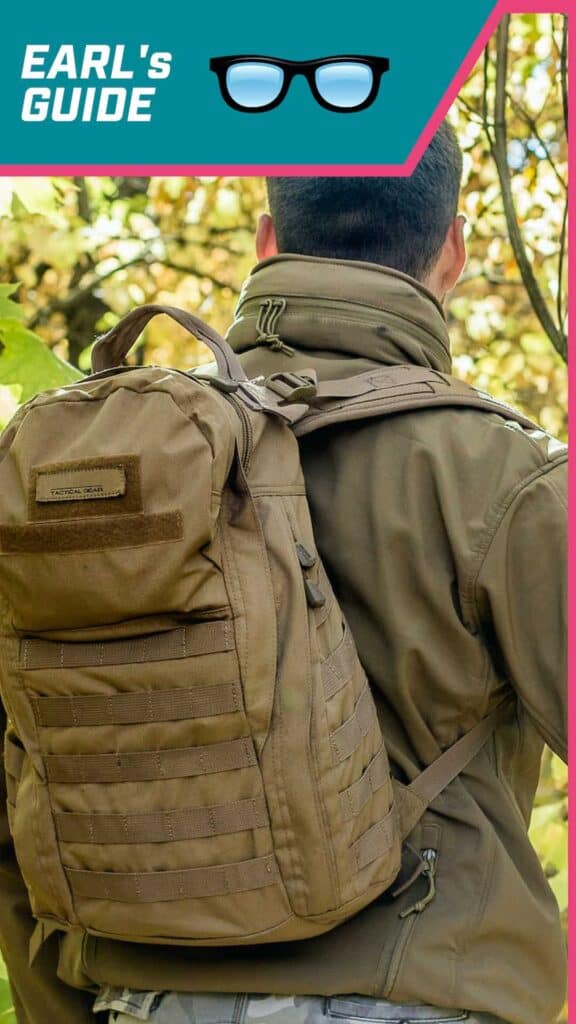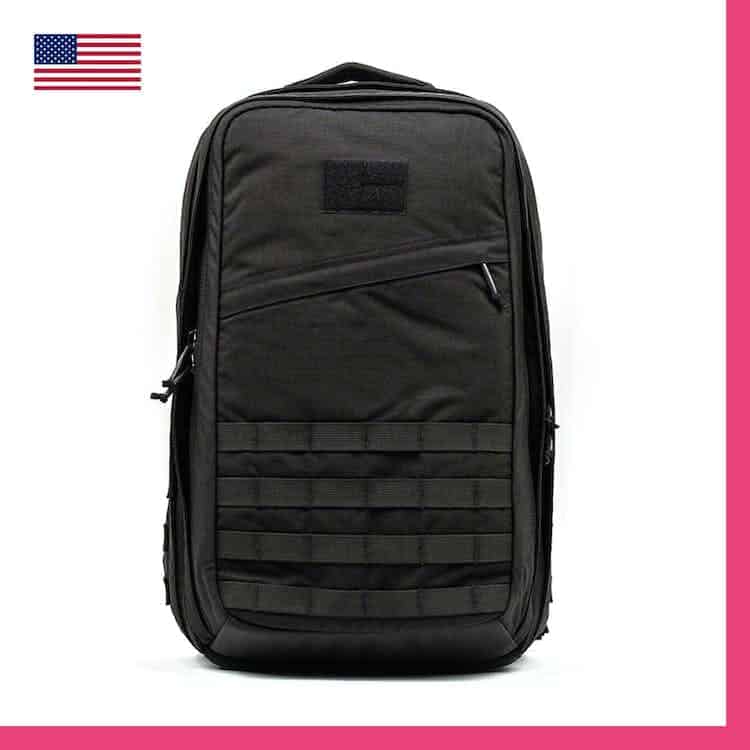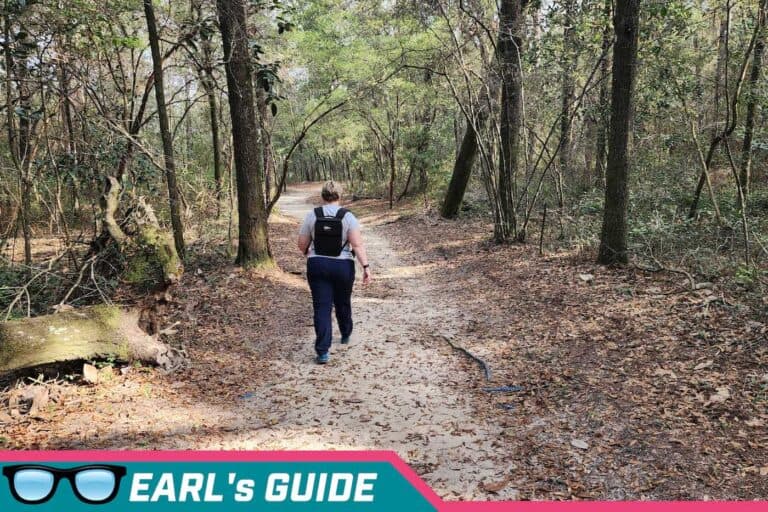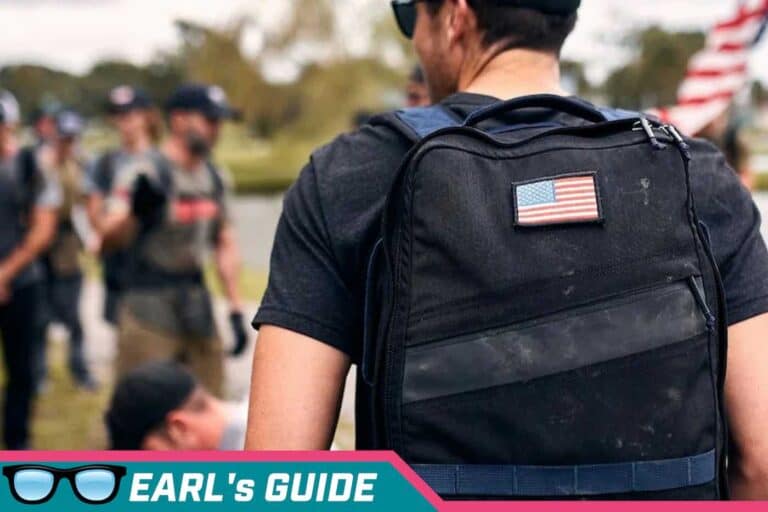Ever wondered how to ruck but felt overwhelmed by all the possibilities and depths of knowledge? Well, you’ve come to the right place.
In this blog post, we’ll cover everything from getting started with rucking basics to more advanced techniques for civilians and military personnel.
We’ll answer all your questions about why people choose to ruck over other exercises, where it came from, what equipment is necessary, and much more.
So get ready for some enlightening answers as you prepare yourself before embarking on a new journey – let’s learn how to get started with rucking.

What is Rucking? & How to Get Started
Rucking is a great exercise that challenges one to combine walking with weight bearing.
It’s simple enough for anyone to get started rucking. It involves doing a ruck march with a backpack full of various weights, such as weight plates, books, or bottles filled with sand or water.
To ensure you are rucking correctly, aim for rucking a couple of times per week and gradually increase the distance and weight throughout the weeks to maximize results.
Rucking is an awesome way to build strength and endurance and can also be tailored to your personal fitness goals and time restrictions, allowing you to have fun while working out.
Choosing the Right Rucking Gear: Backpacks, Boots, Socks, and Clothing
When it comes to rucking, the right gear is a must-have.
Backpacks should be comfortable but durable; you need one that can handle medium and heavy loads.
A pair of boots should fit like a glove and offer support and protection while providing plenty of cushioning; look for waterproof materials and a wide toebox.
The right socks are also essential; they should wick away moisture, regulate temperature and provide extra cushioning throughout your journey.
Finally, clothing should be breathable, lightweight, and fast-drying, so you stay cool and comfortable in any given environment.
With the right rucking gear, you’ll have everything you need for a successful journey.
Backpack
Choosing the best backpack for rucking can significantly impact your weight training regimen.
A weight vest may seem appealing, but backpacks offer an advantage with their wide shoulder straps that evenly distribute weight and minimize discomfort while allowing you to add weight as you progress.
An adequately weighted backpack is important to ensure you can ruck safely and efficiently, as improper weight distribution can increase your risk of pain and injury.
As such, investing in a good quality rucking backpack is highly recommended when joining this form of weight training.
Boots
When choosing the best boots for rucking, there are several things to consider.
A minimal heel-to-toe drop is ideal for ruck marching on various terrain and surfaces, so check this feature before buying a pair of boots.
It’s also important that your boots offer ample foot support to keep your feet happy and healthy as you go on your journey.
Look for a pair that offers ankle and arch support and plenty of cushioning, as these will provide comfort while taking part in a grueling ruck march.
Finally, ensure the boot fits properly before committing to the purchase – nothing ruins a good ruck march like having ill-fitting boots that cause pain and discomfort.
When finding the best boots for rucking, hiking boots may not always be your best bet.
Sure, hiking boots usually have excellent ankle stability. They are made of durable material but can often be too bulky and heavy if you’re just doing shorter-distance rucking.
In this case, opting for lightweight tactical or walking boots instead would be a better option – they provide great support without being too overwhelming or inflexible.
What’s more, when looking for a good pair of rucking shoes, always find something with enough arch support and plenty of cushioning.
You want to make sure you avoid foot fatigue, after all.
Clothing
When it comes to rucking, you want to ensure that your clothing is up to the task.
Choosing the right socks is one of the most important factors in having a comfortable experience.
This is because thickness and heaviness can add additional strain on your feet. For this reason, thick merino wool socks are recommended for rucking, as they keep your feet healthy and help cushion your steps.
They are also much better at wicking away sweat than thinner cotton varieties, making you less likely to experience uncomfortable chafing during longer treks.
Investing in quality merino wool socks will protect your feet while keeping you cool and dry on hotter days.
Rucking Techniques for Proper Form and Posture
Maintaining proper form and posture is critical to ruck safely and getting the most out of the activity.
Some fundamental concepts include keeping the back straight, arms close to the body, and distributing body weight equally on both feet.
Additionally, look ahead when rucking instead of down at your feet while moving forward, especially if you are carrying extra weight.
By including these techniques in your rucking routine, you can experience maximum results with minimum risk of injury.
How to Build Endurance for Long-Distance Rucking
Building endurance for long-distance rucking is no easy task, but it can be done with dedication and consistent effort.
Start by carrying a lightweight on short ruck marches to get used to carrying some of the weight and build your cardiorespiratory fitness.
Add more weight to your pack as you become stronger and more experienced in carrying weights over hilly terrain, which will require more energy output than carrying it over flat surfaces.
Increase the distance gradually until the hike or ruck march starts becoming difficult.
When that happens, rest for a few days before tackling the challenge again so that your body gets enough recovery.
Doing this consistently will help you build endurance for long-distance rucking.
Incorporating Rucking into Your Fitness Routine
Incorporating rucking might be the perfect solution if you’re looking to shake things up in your fitness routine.
Rucking is a modified bodyweight workout requiring carrying a weighted backpack while walking or running.
This type of workout torches calories faster than just lifting weights or running on its own – and not to mention, it gives you an extra strength boost when done correctly.
Adding a rucking workout can help make your body stronger, more efficient, and solid as a rock.
Plus, you’ll reap the cardio benefits of walking at an accelerated pace which can create better body composition and improved performance in other activities.
With this simple but effective exercise, you can make your body journey much more effortless.
The Benefits of Rucking
If done regularly and adequately, rucking can help muscle growth in the lower leg while improving overall stability and strength.
To experience the full benefits of rucking, doing a 2-3 mile ruck march per week with an appropriate amount of weight for your size and fitness level is best.
Not only will this help improve your fitness, but it will also give you more energy and endurance for more rigorous activities.
Nutrition and Hydration Tips for Rucking
Properly fueling your body before, during, and after rucking will help maximize your physical performance and minimize fatigue.
Start by packing a full hydration bladder with plenty of water.
Depending on the intensity of physical training and weather conditions, it is recommended to aim for drinking 1-3 liters of water throughout the day while rucking.
Additionally, eating whole foods such as proteins, fruits, and vegetables will give you the energy to keep going.
Eating suitable food before your physical activities can make all the difference in preserving physical health for effective rucking.
Mindful preparation and smart nutrition choices should be essential when tackling any physical challenge involving rucking.
Rucking on Different Terrains: Hills, Trails, and Pavement
Rucking is a military training exercise that involves carrying extra weight on your back and marching for long distances.
It simulates the conditions for combat training and is an activity that requires strength, endurance, and grit.
Depending on your terrain, you will have different challenges with every type of landscape.
Trails provide a terrain that requires careful navigation as there are uneven farms that may make rucking difficult. Hills bring up the challenge of supporting the extra weight as gravity pulls you down. Pavement surfaces can be rather tedious as they all look similar after a while and can cause more impact on your feet and joints due to the uniform surface.
Nonetheless, ruck marching provides valuable military training regiments to prepare for battles.
Safety Tips for Rucking in Hot or Cold Weather
Rucking is an excellent way to stay in shape and stay outdoors.
However, there are particular safety measures you should follow when doing this activity, especially when it’s hot or cold outside.
To ensure that you have a successful ruck, wear heavier layers of clothing if it’s cold and ensure the weight in your rucksack isn’t more than you usually carry.
Also, remember to bring necessary items like gloves and jackets as part of your proper gear to keep yourself warm during cool weather conditions.
Lastly, make sure you frequently hydrate, even when it’s cold outside. All these tips should help make your rucking experience more enjoyable and safer in the long run.
Using Rucking for Weight Loss and Muscle Building
Rucking is an effective way to shed body weight and build muscle. It provides a progressive bodyweight workout to help you burn calories and raise your heart rate.
Not only does rucking put less strain on knees and ankles than traditional running, but it also engages more muscle groups by having you lift the rucksack itself.
This includes shoulder muscles when lifting, back muscles when carrying the ruck, and core muscles for stability.
By adding bodyweight pushups, lunges, or squats while wearing a weighted backpack, you can increase the intensity of your workout and get even better results.
Rucking is an ideal exercise for those seeking superior body strength and conditioning and losing body fat quickly.
Adding Resistance to Rucking: Sandbags, Weights, and Other Challenges
If you want to take your rucking experience to the next level, adding some resistance can make a difference.
For an extra challenge when rucking, consider training with sand-filled products such as weighted plates, sandbags, jerry cans, and other items.
While increasing the weight you train with, you can also increase your range of motion exercises, which will result in a more effective workout.
As well as strength gains from the variety of objects you train with, you’ll notice much greater endurance in your legs from picking up an additional weight when hiking along long trails.
Adding resistance makes rucking even more entertaining and beneficial.
Group Rucking: How to Find a Ruck Club or Team
Group Rucking is gaining serious traction among veterans and military life as a great way to build strength and camaraderie.
This type of fitness involves carrying a weighted backpack or “rucksack” on your back while engaging in physical activity like jogging, speed walking, or weightlifting.
Getting involved with a Ruck Club or Team is the best way to take part in this military-inspired sport—particularly if you’re an RVer who keeps on the move.
Whenever I arrive in a new area, I fire up the Sandlot App and check the area for a locally active ruck club.
Most clubs meet once or twice per week, usually in local areas, so there’s sure to be one wherever you are. This will allow you to venture out on an empowering group ruck.
Rucking for Military and Tactical Training
Rucking is an essential military and tactical training exercise that prepares you for selection courses and gives veterans of military service the freedom to keep getting the benefits of rucking.
This unique form of physical training doesn’t necessarily require participants to wear combat boots while they walk or march loaded down with a weighted backpack, but a good pair of boots always is recommended.
For military personnel, this has proven beneficial in helping them become accustomed to long marches and demanding physical challenges.
Even after military service, the veteran who stays active with military-style rucking can continue gaining many physical and mental benefits from military training and activity.
Not only does it develop greater overall strength and endurance, but a veteran who keeps up with military-style rucking is also a member of a strong community that enjoys the camaraderie and physical benefits.
Preparing for a Rucking Event or Competition
Preparing for a rucking event or competition can be daunting. Still, you can succeed if you give yourself plenty of time and dedicate yourself to the task.
By bodyweight exercises, such as pushups and squats, as well as fitting in more intensive ruck workouts, like those employed by Sandlot JAX, the GORUCK Games or Chad 1000x, your body will be physically and mentally conditioned for the physical challenges that come with an event like a rucking competition.
With consistency and practice comes success – so don’t shy away from sweating in preparation for the main event.
Cross-Training with Rucking: Combining Rucking with Running, Cycling, or Swimming
Cross-training with rucking is an excellent way to challenge workouts and build strength. Heavier-weight ruck workouts offer an extra edge if you’re used to running, cycling, or swimming but want to take your fitness regimen up a notch.
Think of it as going for a modified spin on the traditional run: instead of jogging with light weights for a few miles, try a heavier load over longer distances.
The same big-muscle activation from a long jog applies to heavier rucks but with added benefit due to the heavier load.
To ensure the best results from these heavier-weight rucks, try interval training—alternate between 2–5 minutes of brisk marching and lighter or heavier pushups or squats for better aerobic conditioning.
With cross-training like this, athletes can become fitter and faster for their favorite sports—and have fun while at it.
Rucking for Mental Toughness: Overcoming Challenges and Achieving Goals.
Rucking is a military-inspired exercise that has become popular among non-military personnel recently.
It utilizes military-style backpacks packed with various weights. It can be done over any distance for an intense physical and mental workout.
Rucking provides the physical benefits of improved cardiovascular fitness, increased strength, and general endurance; it also boosts your mental health by enabling you to push and challenge yourself further than you ever thought possible.
By partaking in rucking, military veterans have utilized the same military training they used during their military career and applied it to post-military life to help them stay mentally tough when faced with various overcoming challenges.
This helps them achieve goals that seemed impossibly out of reach before.
With rucking, you can build better self-confidence, resilience, and determination –all essential traits that will help you exceed the limits of your own mind, muscles, and strength.
Why I love Rucking as a full-time RVer
Rucking is the perfect aerobic and functional fitness routine for those living full-time in an RV.
You only need a sturdy rucksack, comfortable shoes, and clothes you don’t mind getting sweaty during your hikes.
Rucking takes place anywhere – parks, forests, hilly roads, you name it.
You can use an online program to plan your routes for aerobic workouts or follow instructions from a trainer for resistance training.
With minimal equipment and accessibility to any part of the world away from your RV, rucking offers an opportunity to engage in aerobic and functional fitness on a great adventure.
Rucking is an excellent way to train your body and train with sand gear.
Luckily, there’s an app to help make it easier – the Tribe N’ Training App.
This app gives you access to hundreds of workouts, from simple one-mile rucks to more intense six-mile runs.
Additionally, the personal trainers from Tribe N’ Training will create a personalized schedule for you based on your fitness goals and preferences.
Plus, each workout includes detailed instructions on how to best use your rucking backpack and sand gear for maximum benefit (and minimal injury).
With Tribe N’ Training and their app at your disposal, you’ll be able to get into shape in no time.
The Sandlot app is handy for full-time RVers looking to train with sand gear on the road.
With it, active RVers can easily locate ruck clubs in their area.
Connecting with local ruck clubs enables RVers to train in familiar territories surrounded by others who share their love of fitness and the outdoors.
It also allows them to stay fit and motivated when being on the road can be challenging.
Ultimately, the Sandlot App is a must-have for any serious full-time RVer wanting to ruck into their new town.
What is rucking?
Rucking, a term used in military life, is walking with weight on your back. It involves carrying a weighted pack and continuously moving forward to complete a given distance within an allotted time. This physical activity became popular for military personnel due to its utility as a fitness and military drill. The weight and distance of the ruck have varied over time depending on fitness level and military context, making it valuable and adaptable for any military situation. Rucking has become a much-loved military activity amongst servicemen and women, allowing them to recreate military drills at their own pace.
What are the benefits of rucking?
Rucking is a low-impact full-body workout that can be an excellent way to get in shape. It entails carrying a ruck weight, which is any amount of poundage greater than what you would carry with a regular backpack, usually between 10 and 45 pounds. When rucking, you use your upper body and core muscles to stabilize the ruck on your back and help propel it forward. Starting rucking is simple. All you need is a good supportive pair of ruck shoes and ruck weight to start. The benefits of rucking encompass practically all aspects of physical fitness, including but not limited to improving strength, muscular endurance, cardiovascular health, and flexibility. Besides its physical components, rucking also has fantastic mental health benefits, such as boosting self-esteem and improving focus while providing much-needed stress relief after a long day at work.
How do I start rucking?
Starting to practice rucking couldn’t be easier. First, collect your supplies (rucksack/backpack, water, snacks, and clothing layers). Once you have your kit ready, start by doing short rucks around the block a few times a week. Gradually increase the duration and difficulty of each practice session. After you become more experienced and confident with rucking, challenge yourself with a longer one – just make sure you keep a brisk pace the entire time. Don’t forget to take plenty of breaks to rest, hydrate and adjust clothing layers if necessary. You’ll be an expert at rucking with regular practice and proper guidance.
What do I need to go rucking?
Rucking is a fantastic workout that helps users build upper body strength and endurance; all it takes is the right gear and some dedication. Starting out with rucking can be a rewarding experience; all you need to start is a good pair of walking or hiking shoes. From there, you can start with a day pack to get used to carrying a heavier load. If you’re looking to weigh yourself down even more, add a small weight plate or two to the back pockets of your pack and slowly start adding more weight as you become more comfortable. Once you’ve selected your gear, start walking short distances in short spurts – 10-15 minutes – while gradually increasing your pace as you build endurance and strength. As always, staying safe is important, so remember to wear bright colors when trekking on roads, trails, and unsecured paths.
How do I pick the proper ruck?
When it comes to rucking, you want to ensure you have the proper ruck for the job. First, consider ruck weight – are you going on a short ruck or opting for something more challenging? From there, consider comfort and ruck volume; do you need multiple pockets or just one main compartment? Finally, don’t forget about the shoulder straps – make sure they’re adjustable and padded appropriately for comfort. Earl’s Guide to the Best Backpack for Rucking will help narrow down this decision by recommending which brands best meet your needs.
How do I pack my ruck?
Packing your ruck correctly is essential if you are going long distances – the last thing you want is to be weighed down when on the trail. Start by investing in a quality ruck that fits your back and securely stores your belongings. Your items should be organized so that heavier ones are near your center of gravity, and lighter items are loaded on the sides or in front compartments for easy access. Balance is key – ensure not to overload just one side, even though it may be tempting. It’s also important to ensure all straps are secured adequately, so nothing shifts around during movement. Take some extra time when loading up, and you’ll be ready for any journey.
What are some rucking tips and tricks?
Rucking is a great way to get your upper body in shape, as it requires no equipment and provides a challenging full-body workout. To make sure you’re physically prepared for rucking, it’s vital to build up to longer distances slowly – begin with 10 minutes 3 times per week and increase from there. Once you float through those upper body workouts effortlessly, bring an extra challenge by packing a weight vest or backpack/hydration bladder with weights. Finally, for additional resources, plenty of rucking apps can offer guidance and tips to help you on your journey.
How do I stay safe while rucking?
Physical training and preparation are essential for a safe and enjoyable experience when rucking. Trail running shoes are great for daily physical activities. Still, they aren’t suited for the extra weight of a rucksack when you traverse mountains or challenging terrain. To stay safe during these strenuous conditions, investing in quality rucking boots with hard soles that provide extra protection against rocks and debris while also cushioning your feet with enough stability and support is best. Whether you’re simply taking part in a lightweight physical activity or traversing rocky mountain trails, having the right gear will help you stay safe while rucking and enjoy the experience to the fullest.
What are some common rucking mistakes?
Rucking is a fun and efficient exercise, but practicing correctly is important to avoid common mistakes. Good posture is key; having your weight distributed evenly on both feet will help protect against potential back pain or discomfort. Additionally, if you’re new to the practice, build up your experience by starting with shorter distances and smaller weights before progressing. Finally, keep an eye on your form as you move – although taking shortcuts for speed or comfort may seem tempting, it endangers your safety and could result in strain or fatigue. With some practice and proper technique, rucking can be an enjoyable exercise that yields positive results.
How do I troubleshoot rucking problems?
Troubleshooting rucking problems starts with proper posture. Proper posture will make your rucking experience more enjoyable, so it’s important to ensure that you are educated in proper techniques like posture and techniques to prevent injuries. Next, adjusting the weight on your back is important – too much or too little can make it difficult to move smoothly, so finding the correct amount is key. Finally, proper gear and preparations are key to avoiding blisters and other issues while moving over long distances – proper footwear, high-quality socks, and avoiding excessive moisture around your feet are all necessary steps when troubleshooting rucking problems.
Where can I find more information about rucking?
Interested in rucking and looking for more information? You can find a wealth of resources online to help you learn more about ruck workouts, offer specific advice, or help you connect with rucking groups. GORUCK.com, founded by a former Special Operations soldier and U.S. Army Ranger, is a great website; it provides information and advice on rucking events, ruck training programs, rucksacks, and gear at their official store. Additionally, other websites dedicated to rucking provide further details about the activities and organizations related to rucking. So take some time to research rucking to learn how to properly incorporate it into your fitness routine or use it as a support system through adventures with friends or having an all-encompassing outdoor skill set.

Robert Earl
Robert EarlRobert has 20+ years of experience as a Real Estate Agent, Coach, Digital Marketer & Author, coupled with a unique expertise in professional RV Park Management. His time as an RV Park Manager has been marked by a strong ability to increase campground occupancy and revenue through strategic management and targeted marketing efforts. His dual career in online marketing and RV Park Management provides a rich perspective on success in diverse fields. Robert Earl is passionate about teaching and empowering others to pursue their dreams and create sustainable income. Whether through a career in real estate, affiliate marketing, niche blogging, or transforming campgrounds into thriving communities, his proven strategies and techniques have helped numerous individuals and businesses succeed. Based on his years of experience and knowledge in the online marketing industry, along with his hands-on management in the RV Park sector, he has crafted a unique and effective approach to personal and professional growth. In addition to his business pursuits, Robert is also a CrossFit Online Level 1 Trainer (CF-OL1) and enjoys fitness activities, including Rucking workouts while traveling the country. His multifaceted career showcases his dedication to growth, innovation, and the pursuit of excellence in various domains.








